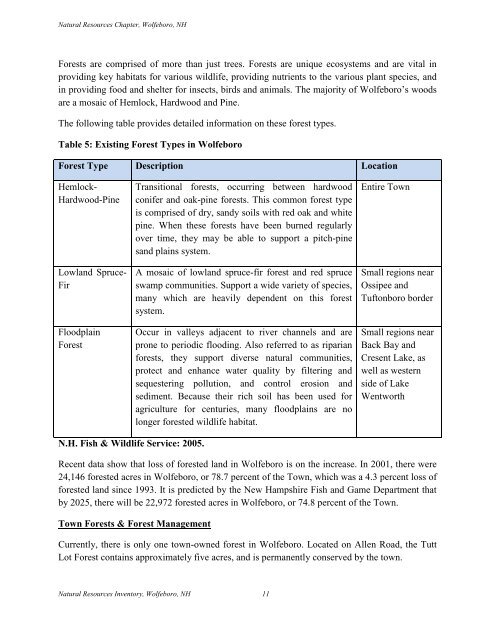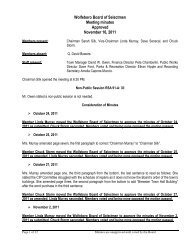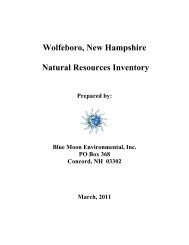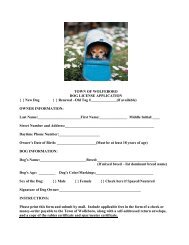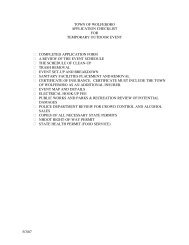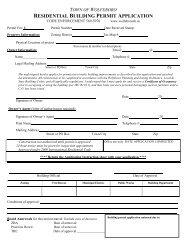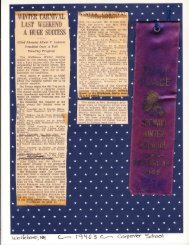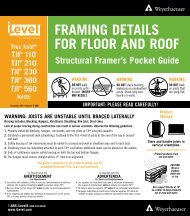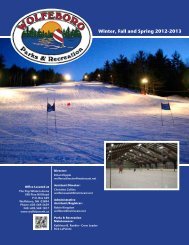Natural Resources Chapter of the Master Plan - Town of Wolfeboro
Natural Resources Chapter of the Master Plan - Town of Wolfeboro
Natural Resources Chapter of the Master Plan - Town of Wolfeboro
Create successful ePaper yourself
Turn your PDF publications into a flip-book with our unique Google optimized e-Paper software.
<strong>Natural</strong> <strong>Resources</strong> <strong>Chapter</strong>, <strong>Wolfeboro</strong>, NH<br />
Forests are comprised <strong>of</strong> more than just trees. Forests are unique ecosystems and are vital in<br />
providing key habitats for various wildlife, providing nutrients to <strong>the</strong> various plant species, and<br />
in providing food and shelter for insects, birds and animals. The majority <strong>of</strong> <strong>Wolfeboro</strong>‟s woods<br />
are a mosaic <strong>of</strong> Hemlock, Hardwood and Pine.<br />
The following table provides detailed information on <strong>the</strong>se forest types.<br />
Table 5: Existing Forest Types in <strong>Wolfeboro</strong><br />
Forest Type Description Location<br />
Hemlock-<br />
Hardwood-Pine<br />
Lowland Spruce-<br />
Fir<br />
Floodplain<br />
Forest<br />
Transitional forests, occurring between hardwood<br />
conifer and oak-pine forests. This common forest type<br />
is comprised <strong>of</strong> dry, sandy soils with red oak and white<br />
pine. When <strong>the</strong>se forests have been burned regularly<br />
over time, <strong>the</strong>y may be able to support a pitch-pine<br />
sand plains system.<br />
A mosaic <strong>of</strong> lowland spruce-fir forest and red spruce<br />
swamp communities. Support a wide variety <strong>of</strong> species,<br />
many which are heavily dependent on this forest<br />
system.<br />
Occur in valleys adjacent to river channels and are<br />
prone to periodic flooding. Also referred to as riparian<br />
forests, <strong>the</strong>y support diverse natural communities,<br />
protect and enhance water quality by filtering and<br />
sequestering pollution, and control erosion and<br />
sediment. Because <strong>the</strong>ir rich soil has been used for<br />
agriculture for centuries, many floodplains are no<br />
longer forested wildlife habitat.<br />
Entire <strong>Town</strong><br />
Small regions near<br />
Ossipee and<br />
Tuftonboro border<br />
Small regions near<br />
Back Bay and<br />
Cresent Lake, as<br />
well as western<br />
side <strong>of</strong> Lake<br />
Wentworth<br />
N.H. Fish & Wildlife Service: 2005.<br />
Recent data show that loss <strong>of</strong> forested land in <strong>Wolfeboro</strong> is on <strong>the</strong> increase. In 2001, <strong>the</strong>re were<br />
24,146 forested acres in <strong>Wolfeboro</strong>, or 78.7 percent <strong>of</strong> <strong>the</strong> <strong>Town</strong>, which was a 4.3 percent loss <strong>of</strong><br />
forested land since 1993. It is predicted by <strong>the</strong> New Hampshire Fish and Game Department that<br />
by 2025, <strong>the</strong>re will be 22,972 forested acres in <strong>Wolfeboro</strong>, or 74.8 percent <strong>of</strong> <strong>the</strong> <strong>Town</strong>.<br />
<strong>Town</strong> Forests & Forest Management<br />
Currently, <strong>the</strong>re is only one town-owned forest in <strong>Wolfeboro</strong>. Located on Allen Road, <strong>the</strong> Tutt<br />
Lot Forest contains approximately five acres, and is permanently conserved by <strong>the</strong> town.<br />
<strong>Natural</strong> <strong>Resources</strong> Inventory, <strong>Wolfeboro</strong>, NH 11


